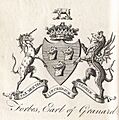George Forbes, 6th Earl of Granard facts for kids
Quick facts for kids
The Earl of Granard
PC
|
|
|---|---|
| Governor of County Longford | |
| In office 1780–1831 |
|
| Succeeded by | George Forbes, Viscount Forbes |
| Personal details | |
| Born |
George Forbes
14 June 1760 |
| Died | 9 June 1837 (aged 76) Champs-Elysées, Paris |
| Spouses |
Lady Selina Frances Rawdon
(m. 1779; |
| Relations | George Forbes, 4th Earl of Granard (grandfather) Letitia Forbes, Countess of Granard (grandmother) |
| Children | 9 |
| Parent | Dorothea Bayly |
George Forbes, 6th Earl of Granard (born 14 June 1760 – died 9 June 1837) was an important Irish general and a noble. He was known for his strong beliefs and his military career. He also held a position in the Privy Council of Ireland, which was a group of advisors to the monarch.
Contents
Early Life and Travels
George Forbes was born on 14 June 1760. He was the oldest son of George Forbes, the 5th Earl of Granard. His mother was Dorothea Bayly. He was also the great-grandson of Admiral George Forbes, the 3rd Earl of Granard.
He went to school in Armagh, Ireland. In 1780, after his father passed away, George became the 6th Earl of Granard. This meant he inherited his father's title and responsibilities.
After becoming an Earl, he went on a long trip around Europe. He visited many places, including Rome, where he met Cardinal Henry Benedict Stuart. He also saw a military parade led by Frederick the Great in Silesia. He spent time living in France and Vienna.
A Life in Politics and the Military
When George Forbes returned home, he became very involved in politics. He held liberal views, which meant he supported ideas like more freedom and rights for people. He worked with famous Irish leaders like Charlemont, Grattan, and Curran.
In 1794, he became a lieutenant-colonel in the army. He also created and led an Irish regiment called the 108th Foot. This regiment was later disbanded in 1796.
George Forbes also formed the Longford militia, a local army group. He led them during the Irish Rebellion of 1798. His regiment faced challenges at the Battle of Castlebar. However, Lord Cornwallis, a senior general, praised George Forbes for his bravery in trying to keep his soldiers together. He was also present when the French forces surrendered at Ballinamuck.
He strongly disagreed with the idea of the "union" between Ireland and Great Britain. This was a major political event that would join the two countries. He was one of only 21 Irish nobles who officially protested against it. After the union happened, he lost his seat in the House of Lords. He then focused on managing his family's lands and was known as a good landlord.
In 1806, he was given the title of Baron Granard of Castle Donington in the United Kingdom. He also received a well-paying job as clerk of the crown and hanaper in Ireland. He continued to advance in the army, becoming a colonel in 1801, a major-general in 1808, and a lieutenant-general in 1813.
Later in his life, George Forbes mostly lived in France. He returned to England to support important laws like the Roman Catholic Relief Act 1829, which gave more rights to Catholics, and the Reform Bills, which changed how people voted. He was offered a higher noble title but turned it down, just as he had refused the Order of St. Patrick earlier. He became a full general in 1830.
Family Life
On 10 May 1779, George Forbes married Lady Selina Frances Rawdon. She was the youngest daughter of John Rawdon, the 1st Earl of Moira. Together, they had nine children:
- Maj.-Gen. Hon. George John Forbes (1785–1836): He was a Member of Parliament for County Longford. He also served as the Lord Lieutenant of County Longford.
- Hon. Francis Reginald Forbes (1791–1873): He became a diplomat, serving as a Minister to Saxony and later to Brazil.
- Capt. Hon. Hastings Brudenell Forbes (1793–1815): He was a soldier who sadly died at the famous Battle of Waterloo.
- Lady Elizabeth Maria Theresa Forbes (1786–1852): She married George Parkyns, the 2nd Baron Rancliffe.
- Other children included Hon. Angoulême Moira Forbes, Hon. Ferdinando William Forbes, Lady Selina Francis Forbes, Lady Adelaide Dorothea Forbes, and Lady Caroline Selina Forbes.
George Forbes passed away in Paris, France, on 9 June 1837, at the age of 77. He was buried in his family's burial place in Newtownforbes, Ireland.
Descendants
Through his eldest son, George John Forbes, he had two grandsons:
- George Arthur Hastings Forbes, who became the 7th Earl of Granard.
- Capt. Hon. William Francis Forbes.
Images for kids


